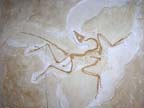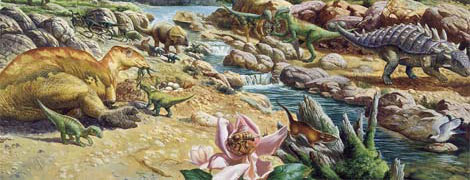 |
 |
 |
 |
 |
Produced
by the Population Genetics and Evolution class, Furman University |
||||
 |
 |
 |
 |
 |
Produced
by the Population Genetics and Evolution class, Furman University |
||||
 |
The
Cretaceous: Hadrosaurs |
 |
||
| Hadrosaurids
were quadrupedal, “duck-billed” dinosaurs of the family Hadrosauridae,
inculding the genera Parasaurolophus and Edmontosaurus
(Wikipedia 2010). They were herbivores that existed in Asia, Europe, and
North America (Wikipedia 2010), and are considered to be the “prehistoric
equivalent” to modern cattle (Dinosaur.about 2010). The large number
of fossils for this group allow for a more thorough description of its
ecology than rarer groups. They appear to be herd animals, perhaps living
in groups of hundreds or thousands of individuals (Dinosaur.about 2010).
They had thick torsos, massive, inflexible tails, tough beaks and numerous
teeth in specialized cheeks; in fact, some had as many as 1,000 teeth
(Dinosaur.about 2010). The two subfamilies are distinguished by the presence
or absence of a crest on the skull: Lambeosaurinae had crest on their
skulls, whereas, Hadrosaurinae did not (Waggoner 2005; Dinosaur.about
2010). Several hypotheses have been suggested for the function of the
crest, including that it was used as a snorkel. However, the most accepted
explanation is that it served as a 'resonating chamber' - creating a loud
bugling noise that was probably used for communication among these social
animals (Dinosaur.about 2010).
Page by Matt Medlin |

|
| Hadrosaur: Parasaurolophus cyrtocistatus skeleton. Photo From: Wikipedia. | |
|
Wikipedia. 2010. Hadrosaurid. Wikipedia. Accessed April 8, 2010. Strauss B. 2010. Hadrosaurs: The Duck-Billed Dinosaurs. Dinosaurus.about.com. Accessed April 8, 2010. Waggoner B. 1995. Introduction to the Hadrosaurs. University of California Museum of Paleontology. Accessed April 8, 2010. . |